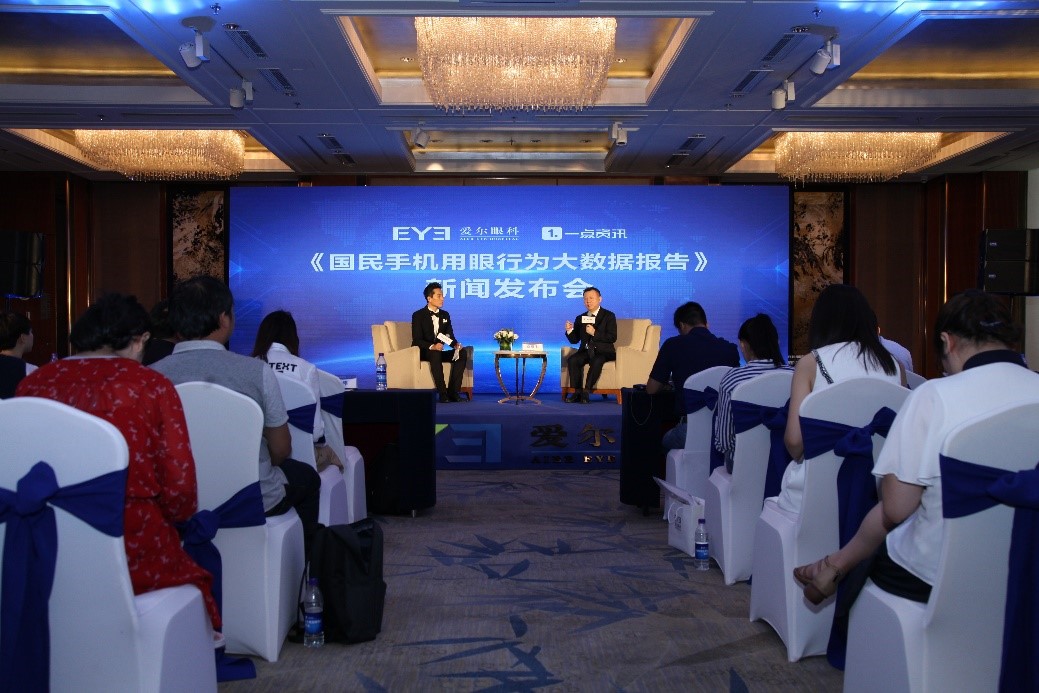On June 5th, the “National Big Data Report of Eye Health with Mobile Phone use” was jointly published in Beijing by AIER Eye Hospital Group and Yidian Zixun. The survey data was shocking to the public, for instance, "753 million mobile Internet users", "Daily hours of watching electronic screens exceed 5.8 hours" and "more than 95% of all people have bad mobile phone eye habits".
Professor Shaowei Li, member of Ophthalmology Group of Chinese Medical Doctor Association of Evidence-Based Medicine Committee, director of AIER Institute for Corneal Disease, PhD supervisor of AIER School of Ophthalmology · CSU, pointed out that, in the age of mobile phone, the load of eye use on mobile phone in China are heavier than ever before. The eye health issue is also particularly prominent in this era. Regular eye health examination and maintain eye health awareness is very important.

On June 5th, jointed by AIER eye hospital group and Yidian Zixun the “National Big Data Report of Eye Health with Mobile Phone use” was published in Beijing.
More than 95 percent of people have bad eye habits with their mobile phones, and nearly 80 percent of them use mobile phones on transportations.
As of December 2017, the number of Internet users in China reached 772 million, of which mobile phone users reached 753 million, accounting for 97.5 percent. The " National Big Data Report of Eye Health with Mobile Phone use " (hereinafter referred to as "Big Data Report") shows that tens of thousands of netizens who participated in the survey spent an average of nearly six hours per day on electronic screens, accounting for 24% of the time all day. On average an individual uses its phone 108 times a day, that is, its mobile phone will be used once every 13 minutes.

Mr. Wenhan Du, the manager of big health department of Yidian Zixun, delivers his speech.
From four dimensions of gender, age, region, and occupation, the "big data report" analyzes the relevance of the public's eye habits, eye-use environment, eye-consciousness, and increasingly severe national eye health conditions. Mr. Wenhan Du, the manager of big health department of Yidian Zixun shows that: From an age perspective, the reasons people become "mobile phone clan" are not the same. In terms of geographical features, it has a lot to do with living habits.
With the increase in the frequency and duration of mobile phone use, a variety of eye habits have emerged. The big data report shows that more than 95% of people have bad eye habits with their mobile phones, the use of mobile phones in vehicles accounted for 79%, with incorrect posture lying (or lying down, etc.) of the use of mobile phones was 66%, and a lot of people use of mobile phones in dark environment or under strong light.

Professor Shaowei Li, member of Ophthalmology Group of Chinese Medical Doctor Association of Evidence-Based Medicine Committee, director of AIER Institute for Corneal Disease, PhD supervisor of AIER School of Ophthalmology · CSU, deliveries his speech.
Prolonged mobile phone light exposure, may increase the incidence of multiple eye diseases.
Prof. Li Shaowei said that the large number of close-quarters work and mobile phones used in modern society have completely changed our traditional lifestyle and eye usage. The harm is inestimable. According to statistics, China currently has more than 600 million people with myopia, 10 million with glaucoma, more than 6 million with cataracts, and 11.6 million with retinal neovascular diseases. With the prevalence of “fingertips”, elderly cataracts, age-related macular degeneration, middle-aged and young-aged glaucoma, dry eye, and youth-prone nearsightedness and oblique amblyopia are rapidly increasing and the average age of patients are getting younger.

Professor Shaowei Li was interviewed by the media from all over the country.
China's juvenile myopia rate is the highest in the world, scientific prevention, control and correction is the most important way.
Electronic screen, bad light, improper posture, long time eye use, and See things too close, and so on, are all important factors that cause aggravation of myopia among juveniles. Among them, cell phones have been the key factor.
At present, China's juvenile myopia rate is the highest in the world: the myopia rate of high school students and college students has exceeded 70 percent and have been increasing year by year. The myopia rate of primary school students is close to 40 percent. By contrast, the rate of myopia among American primary and middle school students is only 10 percent.

The prevention and correction of myopia is of vital importance. Prof. Shaowei Li emphasized that adolescents need to conduct an eye health examination every six months, find eye problems early and correct them in time. Eye health examination must be performed in a professional ophthalmic medical institution. In addition, juveniles must also strengthen outdoor activities, use correct reading and writing postures, and master scientific reading and writing and proper allocation of heavy eye use and rest to protect their eyesight.
 Regular eye examination is very important for protecting eyesight.
Regular eye examination is very important for protecting eyesight.
In order to further enhance the national eye health awareness and strengthen the popularization of scientific eye health knowledge, AIER eye hospital group, as the world’s largest ophthalmology medical chain institution, will publish the Eye Care Collection for newborns, school-age youth, youth, and middle-aged and older people. In addition, during this year's EYE Day, AIER eye hospital group will also hold a series of online and offline eye health education and volunteer clinic activities.
